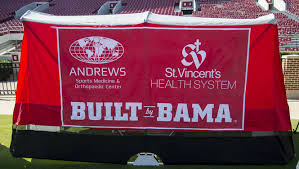
An Alabama player had gotten hurt against Middle Tennessee Sept. 12.
Shortly after, Tide football head athletic trainer Jeff Allen grabbed his walkie-talkie and made a first-time request, “Raise the tent up. We’re on our way.”
In the past, Alabama — like most schools — had people hold up towels and surround the trainer’s table while players were being evaluated in an attempt to provide privacy.
With the tent, that’s unnecessary.
The collapsible tent — which was developed by four students in UA’s College of Engineering – has become a staple of Alabama’s sideline since that game against Middle Tennessee.
When a Tide player is injured, the player and trainers typically head to the tent, which is easily opened and covers the trainer’s table.
That allows for a private evaluation process.
It is quickly looped back to the ground when no longer in use.
“It’s been a fantastic resource for us,” Allen said, “and probably better than we even envisioned.”
Allen came up with the idea during the offseason while brainstorming ways to increase privacy and lessen the distractions when injured players are being evaluated and treated on the sideline during a game.
In May, Allen met with Dr. Charles Karr, the dean of Alabama’s College of Engineering.
Karr later tasked four of senior students in mechanical engineering with constructing the tent as their senior design project.
Allen originally hoped to have a prototype by the end of the season. The students — Jared Cassity, Christian Parris, Jared Porteous and Patrick Powell — told him they would be able have the tent done by the start of the season.
There were two prototypes before the tent was finalized.
It was first utilized in a game against Middle Tennessee.
“Imagine going to the doctor’s office and sitting in the waiting room with 30 or 40 other people in the waiting room and having the doctor evaluate you,” Allen said. “Well, our guys are out on the sideline with 105,000 people watching them, not to mention millions on television. So it really has been beneficial for us.”
When open, the tent is around seven-feet tall, 16-feet long and weighs around 70 pounds.
Typically carried by two people before and after games, it is easily transportable.
It does not obstruct the view of fans at most stadiums, though Allen and members of Alabama’s training staff heard comments Allen declined to repeat from fans at Texas A&M’s Kyle Field Saturday when the tent was opened.
The stands at Kyle Field are uncommonly close to the bench areas of both teams.
The light-grey roof of the tent is transparent enough that trainers don’t need additional light while evaluating players.
In addition, the students used synthetic fabrics that allow for ventilation.
Every part of the tent that touches the ground is covered with heavy-grade ballistic nylon to protect it from wear and tear as well as from players’ cleats.
The exterior was designed to be UV and water resistant while the tent, Cassity said, is durable and “meant to take a hit if it has to.”
The students, Powell said, spent 25-30 hours per week for two months constructing the tent.
Allen said he has already gotten “a ton of calls” from other schools expressing interest in the tent.
“After doing this for 25-plus years, I’ve had so many guys that I’ve evaluated on the sideline that obviously the stress of the injury is compounded by everyone around them looking at them,” Allen said. “So now, we take them in there, and it’s a much more private environment. It’s a closed environment, and they tend to relax a little bit more, and we’re able to get a much better evaluation.”
ORIGINAL ARTICLE:
http://www.al.com/alabamafootball/index.ssf/2015/10/how_four_alabama_seniors_helpe.html